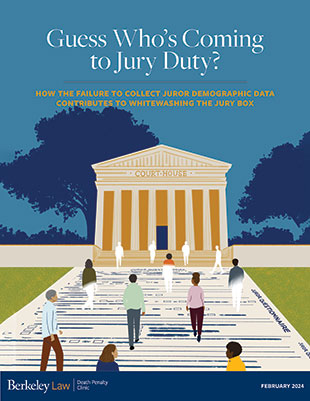 In a new report, the Death Penalty Clinic expands on “Whitewashing the Jury Box: How California Perpetuates the Exclusion of Black and Latinx Jurors,” a 2020 report which investigated the history, legacy, and ongoing practice of excluding people of color — especially African Americans — from state juries through prosecutors’ peremptory challenges.
In a new report, the Death Penalty Clinic expands on “Whitewashing the Jury Box: How California Perpetuates the Exclusion of Black and Latinx Jurors,” a 2020 report which investigated the history, legacy, and ongoing practice of excluding people of color — especially African Americans — from state juries through prosecutors’ peremptory challenges.
“Guess Who’s Coming to Jury Duty?: How the Failure to Collect Juror Demographic Data Contributes to Whitewashing the Jury Box” continues the clinic’s racial justice research and advocacy by cataloging the states that gather prospective jurors’ self-identified race and ethnicity and those that do not. It examines what courts do with the information, including whether it is provided to the court and counsel for use during jury selection, and the consequences of these choices in furthering or obstructing jury representativeness and diversity. In particular, the report shows why the collection of prospective jurors’ self-identified race and ethnicity is vital to meeting state and federal fair cross-section guarantees and eliminating the discriminatory exercise of peremptory challenges.
Racial/ethnic representation and diversity matter to jury decision-making and hence justice cannot be achieved unless courts take a race-conscious approach to jury composition and selection.
The report was researched and written by Elisabeth Semel (Chancellor’s Clinical Professor of Law and co-director, Berkeley Law Death Penalty Clinic), Willy Ramirez, Yara Slaton, Casey Jang (students, Death Penalty Clinic, Berkeley Law Class of ’23), and Lauren Havey (Berkeley Law Clinical Program Paralegal).
Read the report
The report’s findings and recommendations include:
- Currently, 19 states, the District of Columbia, and the federal districts collect race and ethnicity data either from source lists or directly from prospective jurors. While the trend is toward the collection of race and ethnicity information, the pace has been lethargic.
- Every state should adopt a uniform questionnaire that obtains prospective jurors’ self-identified race/ethnicity when they respond to a summons. The form should be publicly available.
- In 16 of the 19 states that collect prospective jurors’ self-identified race and ethnicity, the information is available to trial judges and counsel, either as a matter of statutory law, statewide judicial rule or policy, at the request of counsel, or at the discretion of the individual judicial districts or trial judges.
- Each prospective juror’s self-identified race/ethnicity should be available to the trial court and counsel for the parties prior to the start of jury selection.
- Aggregated, anonymized race/ethnicity data for each judicial district should be published annually by the courts and readily available to litigants investigating jury composition or selection challenges.
Appendix D
Due to its large size, Appendix D, a compilation of juror questionnaires across 50 states and Washington, D.C., is only available online. To view the questionnaires by state, expand the PDF menu in the upper left and click on the second icon to see an alphabetical index.
News stories
States’ Failure to Collect Juror Race Information Contributes to “Whitewashed” Jury Box, Berkeley Law Report Finds, Death Penalty Information Center, 2/27/24